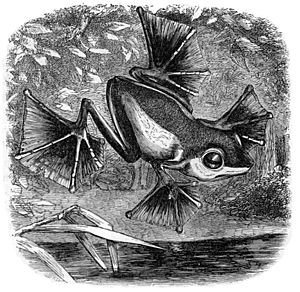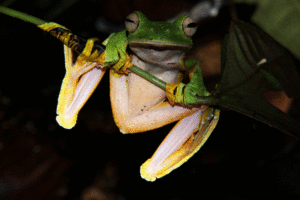Wallace's flying frog facts for kids
Quick facts for kids Wallace's flying frog |
|
|---|---|
 |
|
| Conservation status | |
| Scientific classification | |
| Genus: |
Rhacophorus
|
| Species: |
nigropalmatus
|
The Wallace's flying frog (Rhacophorus nigropalmatus) is a super cool frog! It's also known as the gliding frog. You can find this amazing creature in places like the Malay Peninsula and western Indonesia, including Borneo and Sumatra. It's named after a famous scientist, Alfred Russel Wallace, who first collected a specimen of this frog.
Contents
About the Wallace's Flying Frog
This frog is very interesting to look at. It's quite large, growing to about 80–100 mm long. Female frogs are usually bigger than males. It has big eardrums and large eyes with horizontal pupils. Its legs are very long, and its fingers and toes have webbing right to the tips.
How it Glides
The Wallace's flying frog lives mostly in trees. When it needs to move from one tree to another, or escape danger, it doesn't just jump. It "flies"! It leaps from a branch and spreads out its four webbed feet. It also has a fringe of skin that stretches between its limbs. These membranes and skin flaps catch the air as it falls. This helps the frog glide, sometimes over 50 feet (about 15 meters), to another branch or even to the ground.
To help it land softly and stick to tree trunks, it has extra-large toe pads. These special pads act like suction cups.
What it Looks Like
The back of this frog is a bright, shiny green. Its belly is white or pale yellow. The webbing between its toes and fingers is a brilliant yellow. The base of the webs and a spot on each side of its body are jet black.
This frog looks a lot like the green flying frog (R. reinwardtii). However, the Wallace's flying frog is much bigger when fully grown. Other similar frogs also have more orange web fringes instead of bright yellow.
What it Eats and Who Eats It
Wallace's flying frogs mainly eat insects. But they have also been seen eating small toads and even tiny birds! Tree-climbing snakes are known to hunt and eat these frogs.
Life Cycle and Reproduction
Female Wallace's flying frogs are very clever when it comes to laying eggs. They create a special "bubble nest." They do this by whipping up fluids they produce, usually on a branch or leaves above water.
She lays her eggs in this foamy nest, and the male fertilizes them. The eggs stay safe in the nest as they develop. When the baby frogs, called tadpoles, hatch, the nest breaks apart. The tadpoles then fall into the water below. They continue to grow in the water.
After a while, the tadpoles go through metamorphosis. This means they change from water-dwelling tadpoles into young frogs. Young frogs are red with white spots for about a year. This red color might help protect them by making them look like animal droppings, which predators usually avoid. After about a year, they turn into the green adults we know.
Where it Lives
This amazing frog is found in several countries. You can find it in Thailand, Myanmar, and Peninsular Malaysia. It also lives on the islands of Sumatra in Indonesia and Borneo (which includes Brunei, Malaysia, and Indonesia).
The Wallace's flying frog lives almost entirely in trees. It makes its home in palm trees, bushes, and other similar plants. It has been found in both untouched forests and areas where trees have been cut down. It lives at elevations between 700 and 1800 feet (about 213 to 549 meters) above sea level.
See also




